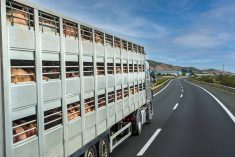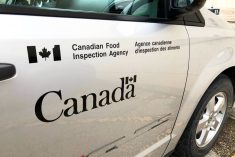Programs laid out in March’s federal budget to help Canada’s beef slaughterhouses better deal with their leftover specified risk materials (SRMs) are now taking applications.
The federal government on Monday launched a abattoir competitiveness program, worth $25 million, and a slaughter waste innovation program, worth $40 million, both backed by the AgriFlexibility fund.
“We’re working with cattle processors to make sure they can become more innovative with specified risk materials, which will help to make them more competitive and the entire value chain more profitable,” Agriculture Minister Gerry Ritz said in a release.
Read Also

U.S. livestock: ‘Cattle on feed’ report supports prices
Chicago cattle futures rose as the USDA’s ‘Cattle on Feed’ report showed inventories two per cent down from a year…
The one-year abattoir competitiveness program, ending March 31, 2011, is meant to help Canadian cattle slaughterhouses maintain “critical” slaughter capacity in Canada for cattle over 30 months of age (OTMs) while the industry “undertakes efforts to become more innovative and competitive when dealing with specified risk materials.”
Federally, provincially and territorially inspected cattle slaughter facilities that slaughtered OTMs in Canada during the 2009 and 2010 calendar years will be eligible for support based on their 2010 production of SRMs from OTMs in Canada, the government said.
The program’s first deadline for applications will be Aug. 16, the government said Monday.
Grants from the program will be based on the volume of SRMs produced, calculated as 58 kilograms per OTM animal and 55 cents per kg of SRMs.
Payments under the program will be based on two time periods, with an initial payment based on January to June 2010, and a final payment based on July to December 2010.
SRMs are the tissues known to harbour the misshaped proteins that cause bovine spongiform encephalopathy (BSE) in infected cattle, including brains, spinal cords and attached nerve ganglia.
All SRMs must be removed from carcasses at slaughter for Canada to remain recognized by the World Organization for Animal Health (OIE) as a “controlled risk” country for BSE.
But disposal remains a challenge for packers who can’t ship those materials for rendering. SRMs are banned from use in food, animal feeds, pet foods and fertilizer.
“Profits”
The three-year slaughter waste innovation program, meanwhile, is expected to help drive “research, development and adoption of innovative technologies or processes to reduce handling costs or return profits from the use or disposal of SRM.”
Those eligible are to include federally, provincially, and territorially inspected cattle slaughterhouses; stand-alone businesses handling SRMs; and research or engineering firms in partnership with these parties or with livestock industry associations.
Program funding for an eligible project “would not normally” exceed 50 per cent of the total eligible project costs, and an eligible project’s total government funding (federal, provincial, territorial, and municipal) cannot be used to cover more than 85 per cent of its eligible costs.
The program will pay out no more than $10 million to any one recipient over the program’s three-year lifespan, the government said.
Application deadlines for the waste innovation program will be announced “shortly,” the government said Monday. Applications will be put through for review based on their “overall relevance” to the program’s goals.















